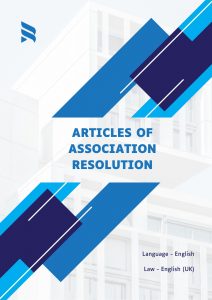In corporate governance, the decisions crafted by a board of directors serve as the compass guiding a company’s trajectory. Among these decisions, special resolutions stand out as significant milestones, marking pivotal moments in a company’s evolution. But what specific scenarios prompt a UK board of directors to convene and pass a special resolution?
Understanding the Significance
Before delving into the nuances of when a special resolution is required, it’s essential to grasp its significance. In the United Kingdom, a special resolution is a formal mechanism mandated by company law. It demands a higher threshold of approval compared to ordinary resolutions and is typically reserved for matters that substantially alter a company’s structure, governance, or legal status.
Key Scenarios Requiring Special Resolutions:
- Amendment of Articles of Association:
The Articles of Association serve as the legal framework governing a company’s internal operations, defining the rights and responsibilities of its members, directors, and other stakeholders. Proposed amendments to these foundational documents often stem from evolving business needs, regulatory changes, or strategic realignments. Such modifications can encompass a wide range of provisions, including alterations to share classes, voting rights, dividend policies, or governance structures. Before implementing any amendments, the board must undertake a comprehensive review to assess the potential implications on the company’s operations, compliance obligations, and stakeholder interests. By convening a special resolution, the board provides shareholders with a platform to evaluate the proposed changes, express their views, and exercise their voting rights in a transparent and democratic manner. This process fosters engagement, accountability, and trust among shareholders, reinforcing the company’s commitment to robust corporate governance practices and stakeholder alignment.

- Alteration of Share Capital:
Changes to a company’s share capital structure represent fundamental transactions that can impact its financial stability, capitalization, and shareholder value. Whether seeking to raise capital through share issuances, consolidate shares to simplify ownership structures, or reduce share capital to address financial exigencies, such decisions require careful consideration and shareholder approval. A special resolution provides a formal mechanism for shareholders to deliberate on the proposed changes, assess their implications, and make informed decisions in the best interests of the company. Moreover, complying with legal requirements for special resolutions underscores the board’s commitment to transparency, accountability, and shareholder democracy. By engaging shareholders in the decision-making process, the board enhances trust, fosters alignment, and reinforces the company’s reputation as a responsible steward of investor capital. - Change of Company Status:
The decision to change a company’s legal status, such as transitioning from a public limited company (plc) to a private company limited by shares (Ltd), reflects strategic considerations, market dynamics, or regulatory requirements. Such transitions entail complex legal, financial, and operational implications, including changes in reporting obligations, shareholder rights, and governance structures. Before effecting any change of company status, the board must conduct a thorough analysis of the potential benefits, risks, and implications for stakeholders. By convening a special resolution, the board provides shareholders with an opportunity to deliberate on the proposed transition, seek clarifications, and express their views on the matter. This process promotes transparency, accountability, and stakeholder engagement, enhancing trust and confidence in the company’s leadership and strategic direction. - Appointment or Removal of Directors:
The composition and effectiveness of a company’s board of directors play a pivotal role in shaping its governance practices, strategic decision-making, and long-term performance. While the appointment of directors often follows standard procedures outlined in the company’s Articles of Association and corporate governance guidelines, the removal of a director from office warrants a more rigorous process. Such decisions may arise due to concerns over performance, conflicts of interest, or breaches of fiduciary duties. Before initiating any removal proceedings, the board must adhere to legal requirements and procedural safeguards to ensure fairness, transparency, and accountability. Convening a special resolution allows shareholders to evaluate the grounds for removal, assess the director’s performance, and express their views on the matter. This process reinforces principles of shareholder democracy, corporate accountability, and board effectiveness, bolstering trust and credibility in the company’s governance practices.

- Voluntary Winding-up:
The decision to initiate voluntary winding-up proceedings represents a significant milestone in the life cycle of a company, marking the cessation of its operations and the commencement of liquidation processes. Such decisions may be prompted by financial insolvency, strategic realignment, or shareholder consensus. Before embarking on winding-up proceedings, the board must assess the company’s financial position, liabilities, and obligations to creditors and shareholders. Convening a special resolution provides shareholders with an opportunity to deliberate on the proposed course of action, weigh alternative options, and make informed decisions in the best interests of all stakeholders. This process fosters transparency, accountability, and stakeholder engagement, mitigating potential conflicts of interest and legal risks associated with winding-up proceedings. By adhering to statutory requirements and facilitating open communication with shareholders, the board navigates the winding-up process with integrity, diligence, and respect for stakeholders’ rights and interests.
In corporate governance, special resolutions serve as the linchpin that binds strategic decisions with legal formalities. By discerning the scenarios necessitating a special resolution, UK boards of directors can navigate complex challenges with clarity, integrity, and accountability.
These resolutions embody the essence of shareholder democracy, ensuring that significant corporate actions are subject to rigorous scrutiny and consensus-building. As custodians of corporate stewardship, UK boards of directors wield special resolutions as instruments of prudent governance, steering their companies towards sustainable growth, resilience, and ethical conduct.

